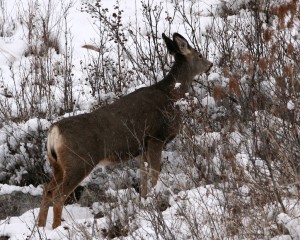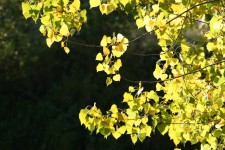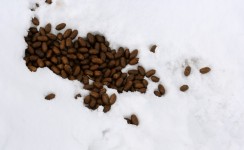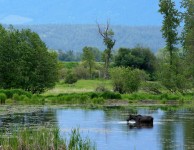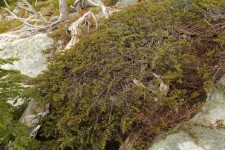A deer munches on the tips of young trees, ripping the leafless twigs from the plants. Surviving the winter on twigs isn’t very nutritious but the stomachs of deer are equipped to squeeze all the nutrients they can out of the tough twigs.
All ruminants (the deer family, antelopes, sheep, goats, cattle and giraffes) sustain themselves on leaves, twigs, grass and other plant matter since they are herbivores. To extract the most from plant matter, ruminants have a four-chambered stomach–not four stomachs as some people say.
The four-chambered stomach allows for ruminants to process low-nutrient food in large quantities. The first chamber (rumen) of a deer stomach can hold eight to nine quarts of plant matter. Within one to two hours a deer can fill its rumen unless food is scarce.
One benefit of the four-chambered stomach is that ruminants don’t have to thoroughly chew the first time like humans chew food. Instead, ruminants chew their food enough to swallow it. Then the food is stored in the rumen.
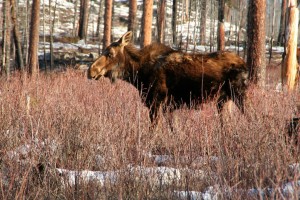
Moose are primarily browsers year round meaning they consume leaves, bark and twigs from trees and shrubs
This allows ruminants to eat as much as possible in the shortest amount of time and minimizes the time they are less alert to predators. When a deer eats, the noise of eating vegetation decreases the chance of it hearing a predator.
After the rumen is full, ruminants seek a location where they can be alert and chew their food again. Have you heard of cows chewing their cud? Deer, elk and moose do the same thing–the process is called rumination.
Almost unconsciously, ruminants regurgitate the food (called cud or bolus) to chew again. For deer, the cud is about the size of a large lemon. A white-tailed deer chews its cud an average of 40 times while mule deer average 56 chews.
The cud doesn’t look like the original plant matter because the rumen also acts as a big fermentation tank. Microorganisms, such as bacteria, protozoans and fungi, in the rumen break down the plant matter by attacking the cellulose.
A symbiotic relationship (beneficial to both organisms) between the microorganisms and the ruminants exist. The ruminant provides food and living space for the microorganisms and the microorganisms break down the plant matter into components the ruminant can utilize.
The microorganisms break down plant matter anytime it enters the rumen. When a ruminant chews its cud it breaks down the plant matter even more, exposing more surface area for the microorganisms to attack once it is swallowed again.
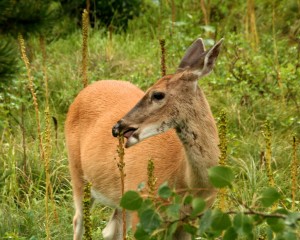
For every 100 pounds of food a deer consumes, 65 percent goes towards growth, maintenance and heat production; 5 percent is lost as methane; 5 percent turns into urine and 25 percent turns into feces
Then the smaller particles of food pass into the reticulum (the second chamber) which has the main function of filtering out foreign material (such as stones and hair) and water. A deer reticulum only holds about a softball-sized amount of food.
The reticulum continues to break down the plant fibers and allows only the finest particles to pass to the omasum (the third chamber) where more intensive digestion and absorption occur.
Food in the omasum passes to the abomasum (fourth chamber) in a liquid slurry. Gastric juices continue digestion before passing the liquid into the small intestines.
In addition to the plant matter, the microorganisms pass through the chambers of the stomach and are also digested by the ruminant (the not so beneficial part of the relationship).
Throughout the process, the microorganisms also detoxify plant poisons, synthesize vitamins and create proteins from nitrogenous compounds. These processes help the microbes and ruminant survive. Ruminants derive more nutrition from the compounds the microorganisms create than the actual plant matter itself.
But even the microorganisms can’t turn all twigs into a gourmet meal. Older plant material has a lower nutritional value and a higher proportion of indigestible material. Therefore in winter when a deer’s rumen is full of older plant material that microorganisms can’t handle, the deer can feasibly starve on a full stomach.

